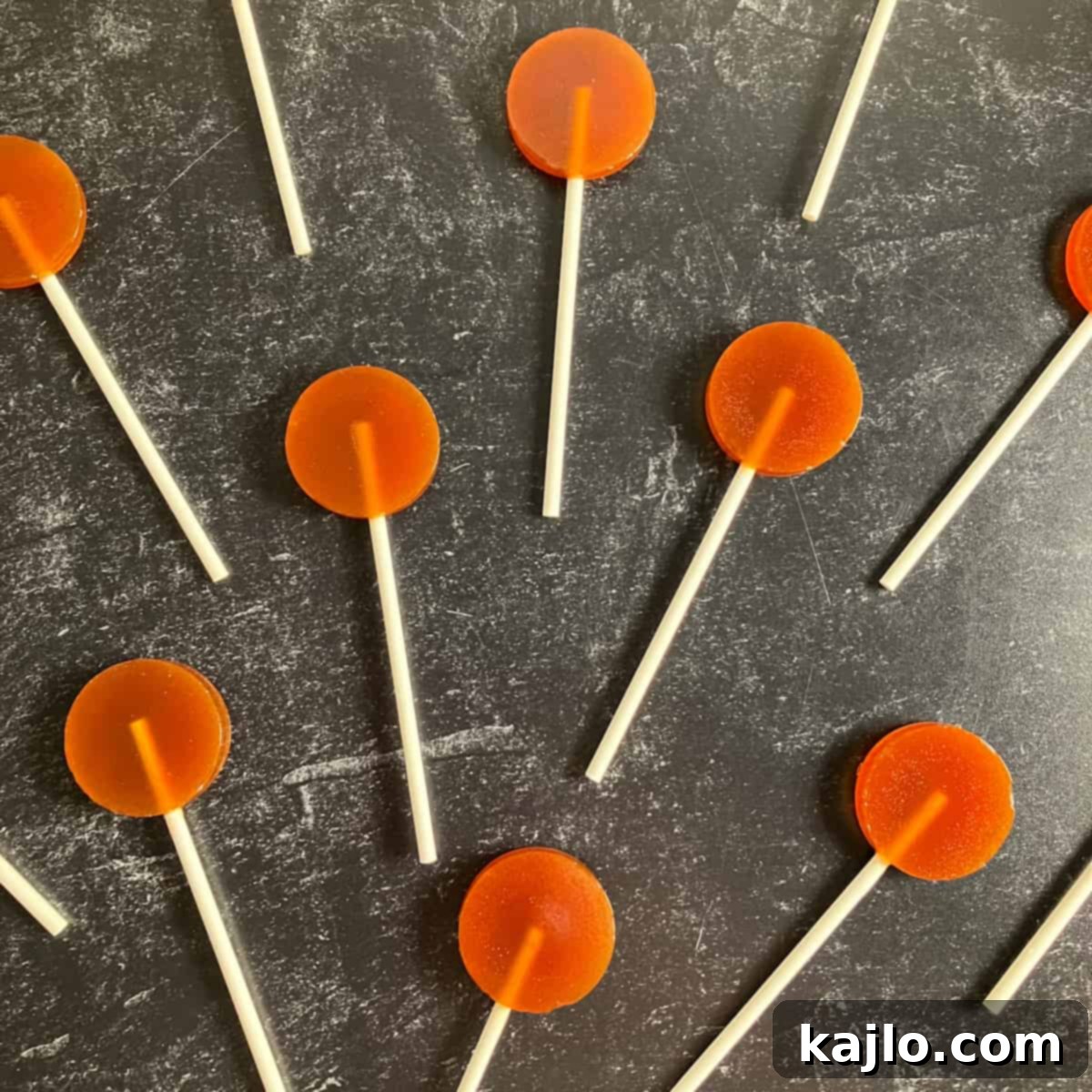Discover the Sweet Simplicity: Homemade Honey Lollipops (No Refined Sugar!)
Craving a delightful treat that’s naturally sweet and easy to make? Look no further than this incredible honey lollipop recipe! Whether you affectionately call them honey pops, honey suckers, honey candy, or simply honey lolly, these pure honey lollipops are a fantastic, refined-sugar-free alternative to traditional sweets. Perfect for a soothing addition to your tea, a comforting home remedy for coughs, or just a simple, wholesome indulgence. While delicious plain, adding a hint of lemon and ginger elevates them into an extra special, aromatic delight!

In a world often filled with overly processed sweets, these homemade honey lollipops stand out as a beacon of natural goodness. Made with just a few simple ingredients, they offer a healthier way to satisfy your sweet tooth without compromising on flavor. Get ready to embark on a sweet journey that’s both rewarding and incredibly tasty!
The Allure of Pure Honey Lollipops
Honey has been cherished for centuries not only for its distinct sweetness but also for its natural properties. Unlike refined sugars, honey contains beneficial compounds, making it a more wholesome choice. Crafting lollipops solely from honey means you’re enjoying a treat that harnesses honey’s inherent flavor and charm. They’re often softer and melt-in-your-mouth compared to their corn syrup counterparts, offering a unique sensory experience. These lollipops are more than just candy; they are a nostalgic nod to simpler times and a testament to the versatility of nature’s golden nectar.
🍯 Essential Ingredients for Your Honey Pops
Making these delightful honey suckers requires just a handful of simple ingredients:
- ½ cup pure honey: The star of our recipe! Any good quality, liquid honey will work. Lighter honeys tend to yield a more traditional “honey” flavor, while darker honeys can add complexity.
- ¼ teaspoon lemon extract (optional): This adds a bright, zesty note that beautifully complements the honey. If you prefer, you can use edible and food-safe lemon essential oil, but be sure to use a very small amount as essential oils are potent. Fresh lemon zest can also be an option for a milder flavor.
- ¼ teaspoon ginger powder (optional): For a warm, slightly spicy kick that pairs wonderfully with both honey and lemon. Ground cinnamon is a fantastic alternative for a different flavor profile.
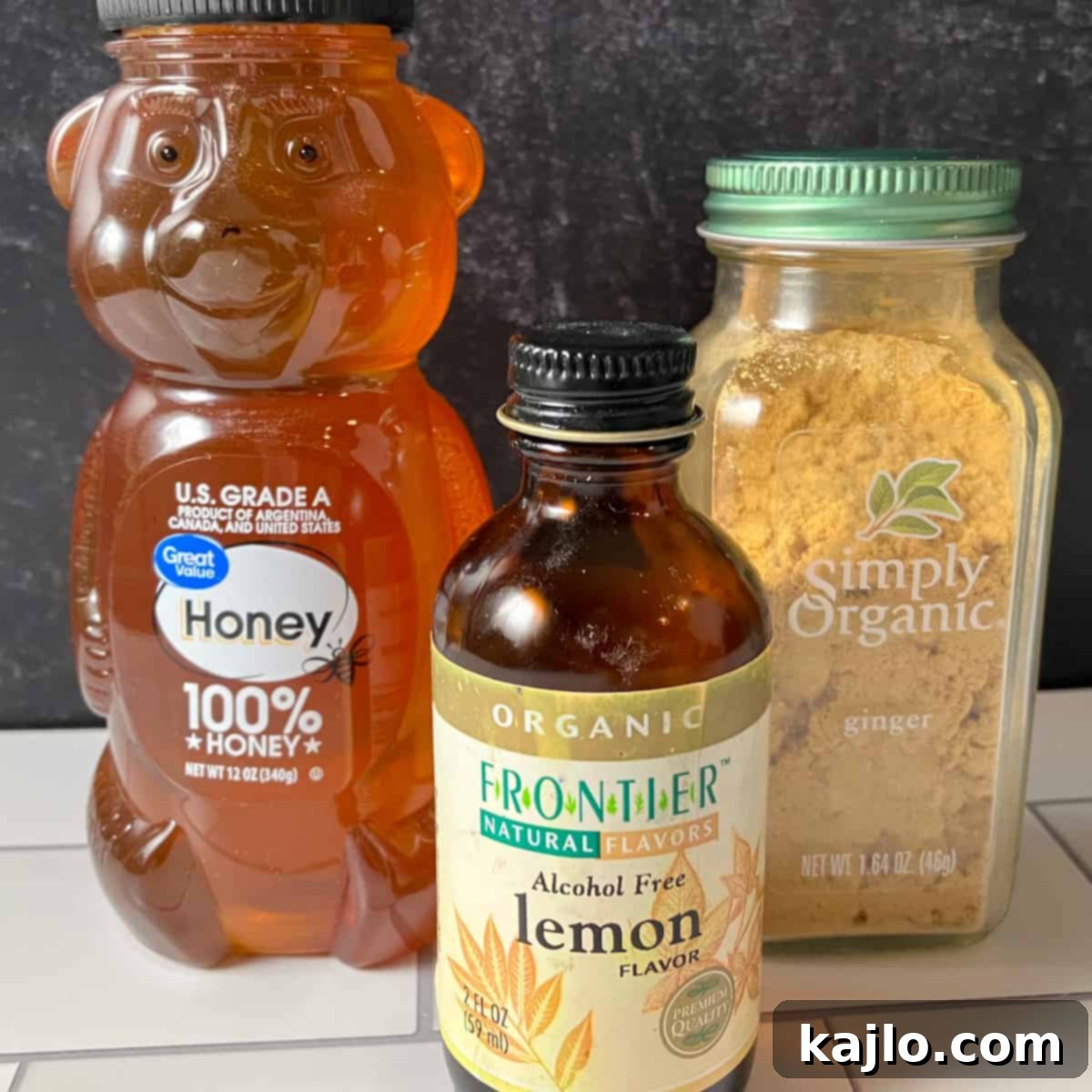
This recipe provides a solid foundation, but the possibilities for customization are truly endless!
Unleash Your Creativity: Flavor Variations and Substitutions
This honey lemon lollipop recipe is incredibly versatile, inviting you to experiment with a wide array of flavors. Don’t be afraid to make it your own! Here are some ideas to inspire your next batch:
- Spice Swaps: Instead of ginger, try a pinch of cinnamon for a warming, autumnal flavor, or a dash of cardamom for an exotic twist.
- A Hint of Heat: For those who enjoy a little kick, add a tiny pinch of cayenne pepper. It creates a surprising and invigorating contrast to the sweetness of honey.
- Citrus Alternatives: Swap the lemon extract for orange, lime, or even grapefruit flavoring to create different citrusy profiles. A touch of orange blossom water could also add a floral complexity.
- Herbal Infusions: Consider infusing your honey with culinary herbs like lavender, rosemary, or mint before cooking. Strain the herbs out before proceeding with the recipe.
- Extract Adventures: Experiment with other food-grade extracts such as vanilla, almond, or even a hint of peppermint for a refreshing lollipop.
- Sweetener Alternatives (with caution): While this recipe is designed specifically for honey, some adventurous cooks might consider maple syrup or even vegan honey substitutes. However, please note that these alternatives will likely alter the texture and cooking time due to their different sugar compositions and water content. Extensive testing would be required to ensure proper hardening and a successful lollipop.
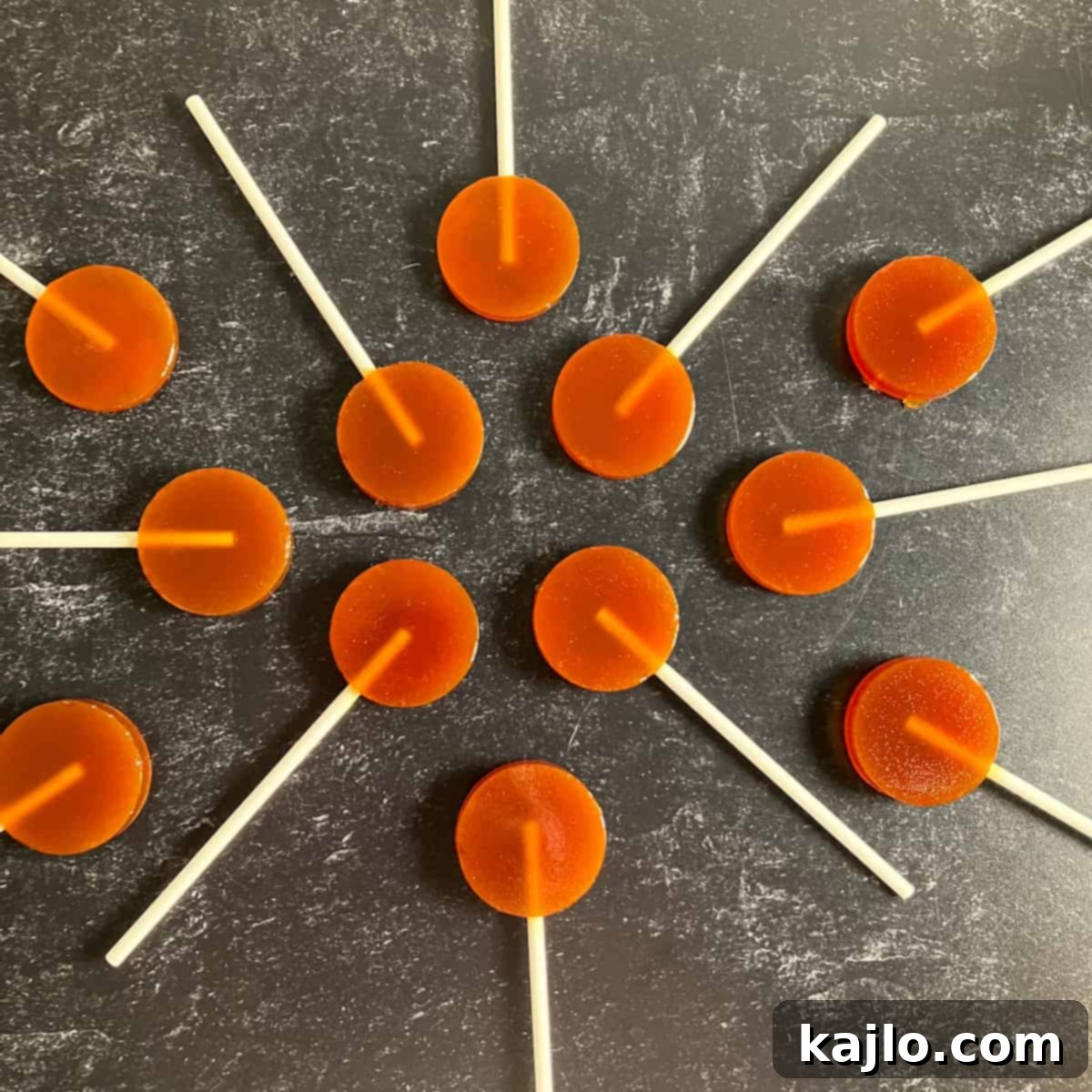
The key is to have fun with it! These lollipops are a delightful canvas for your culinary imagination.
Essential Equipment for Homemade Honey Lollipops
To successfully create homemade honey lollipops, you’ll need a few specialized kitchen tools:
- Candy thermometer: This is absolutely crucial for reaching the precise temperature required for hard candy (the hard crack stage). Without it, your lollipops may end up too soft, too sticky, or burnt.
- Silicone lollipop molds: These flexible molds make it incredibly easy to release your hardened lollipops. Molds come in various sizes, with larger ones yielding fewer, bigger lollipops, and smaller ones producing more, bite-sized treats.
- Lollipop sticks: Essential for turning your honey candy into convenient, handheld lollipops.
- Cellophane wrapping bags with ties: Individually wrapping your finished lollipops is highly recommended. This prevents them from sticking together, protects them from humidity (which can make them sticky), and keeps them fresh.
I personally recommend a silicone lollipop mold kit designed for hard candy. Many of these kits conveniently include the lollipop sticks, treat bags, and twist ties, eliminating the need to purchase these items separately and streamlining your candy-making process.
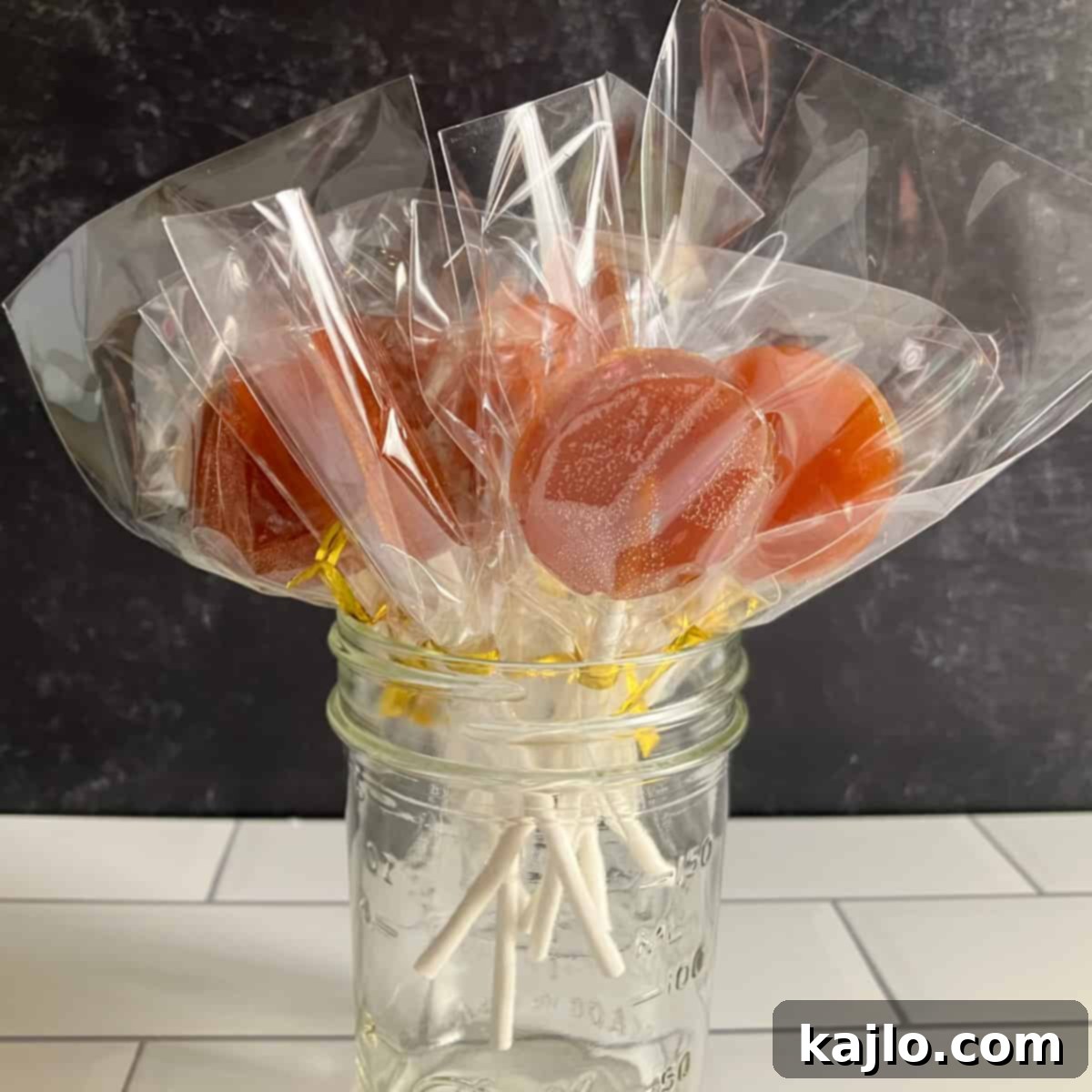
Understanding the Hard Crack Stage
The “hard crack stage” is a critical term in candy making. It refers to a temperature range (typically 300-310°F or 149-154°C) where sugar syrup, when dropped into cold water, forms hard, brittle threads that snap easily. Achieving this stage is vital for creating lollipops that harden properly and aren’t overly sticky. A candy thermometer ensures accuracy, preventing both undercooked (soft) and overcooked (burnt) honey.
Can you use honey instead of corn syrup in lollipops?
Yes, you absolutely can use honey instead of corn syrup in lollipops, but it’s important to understand the differences it will create. Honey is an invert sugar, much like corn syrup, which helps prevent crystallization. However, honey has its own unique composition, flavor profile, and water content that will alter the final product compared to a corn syrup-based lollipop.
Honey-only lollipops tend to be softer than traditional hard candy lollipops and have a delightful melt-in-your-mouth quality. They also have a more distinct, complex flavor from the honey itself. The texture will be less glass-like and more akin to a hard chew or a solid, dense caramel. Because honey contains different sugars (fructose, glucose) in varying ratios compared to corn syrup, it behaves slightly differently under heat. It can also be more prone to burning due to its natural sugars. Therefore, diligent stirring and precise temperature monitoring with a candy thermometer are essential to prevent scorching.
For a classic, super-hard, clear lollipop, a significant amount of granulated sugar or corn syrup is typically required, with honey often added in smaller quantities for flavor. This recipe, however, focuses on celebrating the unique qualities of honey as the primary sweetener, resulting in a distinctively different, yet equally delicious, lollipop experience.
🍭 The Easy Honey Lollipop Recipe
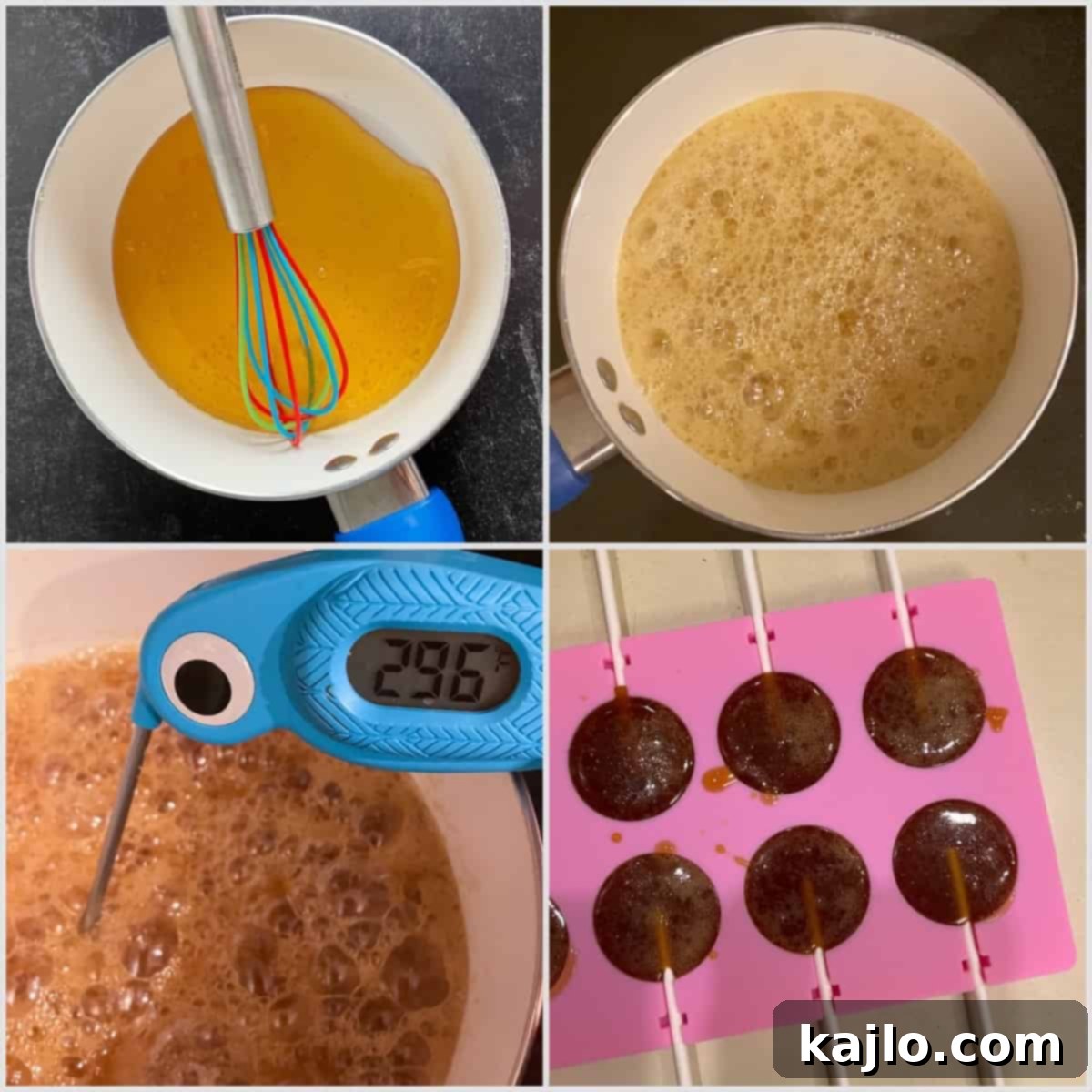
Ready to create your own batch of delicious honey suckers? Follow these simple step-by-step instructions for success:
Step 1: Gentle Heating
Pour the measured honey into a small, heavy-bottomed pot. Place the pot over medium heat on your stovetop. Using a non-stick pot will significantly simplify the cleaning process later on, as hot honey can be quite sticky.
Step 2: Reach the Hard Crack Stage
Insert your candy thermometer into the honey, ensuring it doesn’t touch the bottom of the pot. Heat the honey precisely to 300 degrees Fahrenheit (150°C), which is the crucial hard crack stage. This temperature is essential for your lollipops to properly harden. Whisk the honey gently and occasionally as it heats to prevent it from scorching, especially at the bottom. Do not walk away from the pot! Honey burns easily, and going even slightly over 300°F can result in a bitter, burnt flavor.
Step 3: Infuse Flavors
Once the honey reaches 300°F, immediately remove it from the heat. Swiftly stir in the lemon extract (or essential oil) and ginger powder. Work quickly at this stage, as the honey will begin to cool and thicken rapidly. Ensure the flavorings are evenly incorporated.
Step 4: Fill the Molds
Carefully pour about 1 teaspoon of the hot honey mixture into each compartment of your silicone lollipop molds. Place a lollipop stick into each filled compartment, pressing it gently into the honey to ensure it’s fully coated and secure. Then, cover the stick with an additional ½ teaspoon of honey. Again, speed is key here – the honey cools and hardens quickly. If you use the standard lollipop molds recommended, this recipe should yield approximately 12 perfectly sized lollipops.
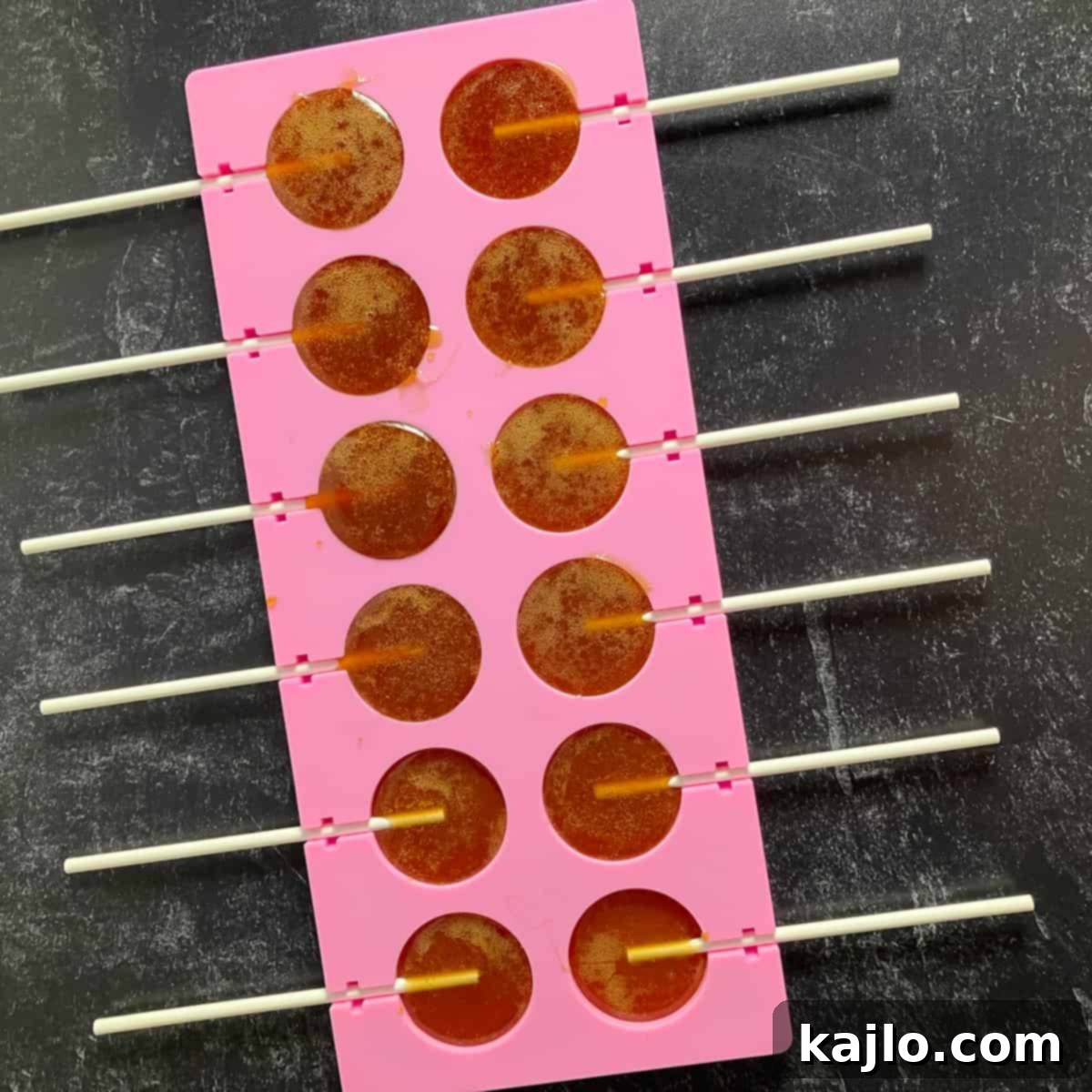
Step 5: Cool and Store
Allow the filled molds to sit at room temperature for a few minutes, then transfer them to the refrigerator for at least 1 hour, or until completely firm. Once fully hardened, the lollipops should easily pop out of the flexible silicone molds. Store these delightful (no white sugar) honey lollipops in an airtight container in the refrigerator, where they will keep indefinitely, much like pure honey itself (source). They also freeze exceptionally well for longer-term storage. It’s important to note that these healthy honey lollipops will become soft and sticky if left at room temperature for extended periods, especially in humid environments, due to honey’s hygroscopic nature.

Important Safety Considerations for Honey Lollipops
While these honey lollipops are a wonderful treat, it is crucial to be aware of important safety guidelines:
- Infants Under One Year: Honey should never be given to babies under one year of age due to the risk of infant botulism (source). Their digestive systems are not yet mature enough to handle potential botulism spores, which can be present in honey.
- Choking Hazard: Lollipops, by their nature, present a choking hazard. This makes them unsafe for young children, typically those under at least four years of age, or anyone with underdeveloped swallowing mechanisms or other swallowing difficulties. While honey lollipops may melt more easily than traditional hard candy, they can still form a sticky, pliable glob that poses a significant choking risk.
- Supervision: Even for older children and adults, it’s always wise to consume lollipops responsibly and under supervision if there are any concerns about choking.
Please prioritize safety and ensure these honey lollipops are only enjoyed by those who can safely consume them.
How to make Manuka honey pops?
If you’re considering using expensive Manuka honey for this recipe, it’s essential to understand its unique properties. While you could technically substitute Manuka honey for regular honey, it’s generally not recommended for cooked applications like lollipops.
Manuka honey is prized for its distinct antibacterial properties, which are attributed to its MGO (methylglyoxal) content and other beneficial enzymes. Exposing Manuka honey to excessive heat (above 104-105°F or 40°C) can degrade these delicate enzymes and potentially reduce its unique beneficial compounds (source). Since this lollipop recipe requires heating the honey to 300°F (150°C), you would largely lose out on the very qualities that make Manuka honey so special and costly.
Therefore, I advise against using Manuka honey for lollipops or any cooked candy. It’s best enjoyed in its raw form, perhaps stirred into warm (not hot) tea or coffee (ensure the beverage is no hotter than 105°F), or consumed directly. For homemade candy, stick to regular, raw honey that isn’t heat-sensitive, allowing you to enjoy the delicious taste without compromising potential health benefits of specialty honeys.
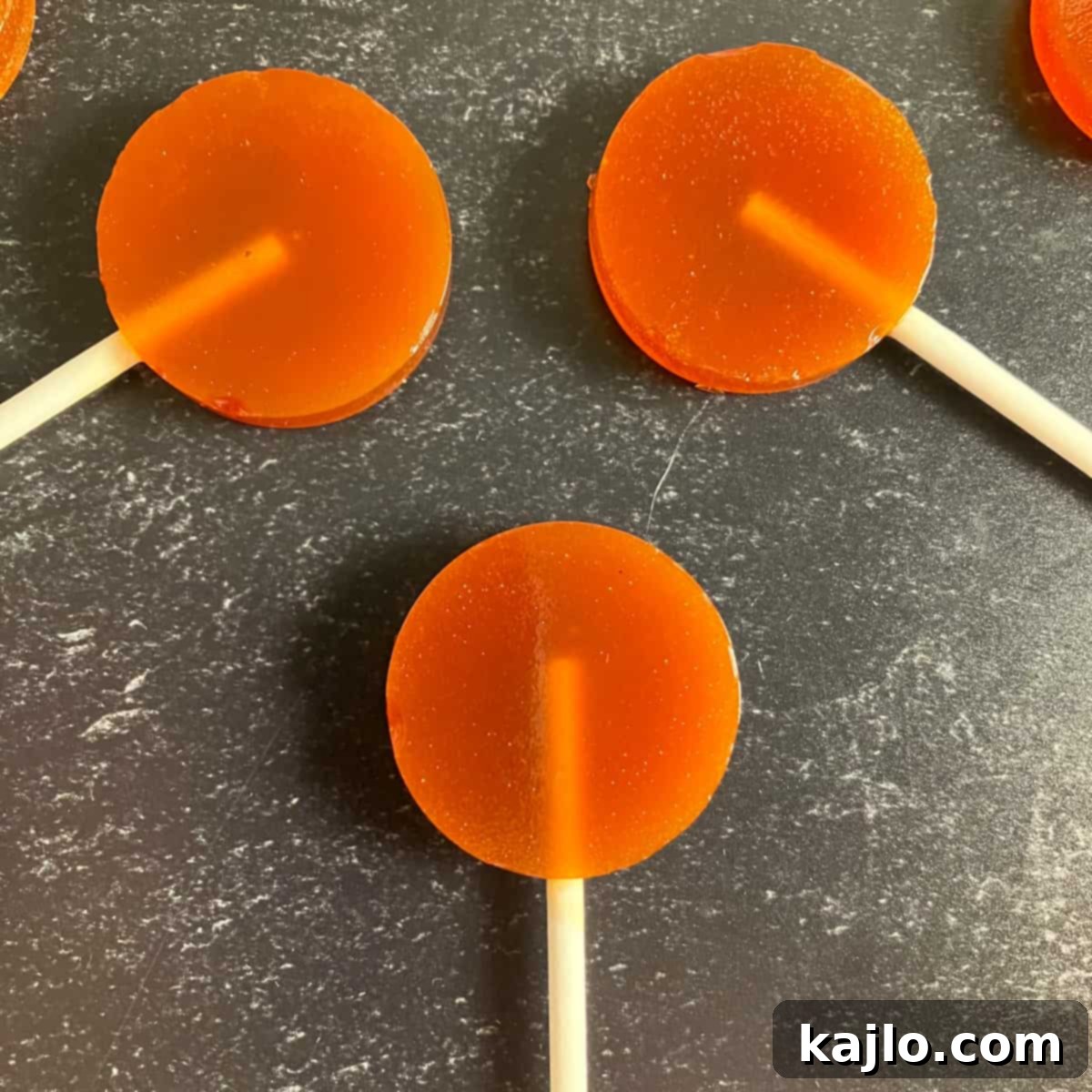
FAQs About Honey Lollipops
How do you make homemade honey lollipops not sticky?
Honey lollipops made with 100% honey have a natural tendency to become sticky, especially when exposed to room temperature or humidity. Honey is hygroscopic, meaning it absorbs moisture from the air, which leads to stickiness. To significantly decrease their stickiness, always store honey lollipops in an airtight container in the refrigerator. For a lollipop that is less prone to stickiness, consider a more traditional recipe that uses a higher ratio of granulated sugar or corn syrup, with just a touch of honey added for flavor. These sugars, when cooked to the hard crack stage, create a more stable, less hygroscopic candy.
How to make honey lollipops with no mold?
You can absolutely make honey lollipops without a specialized mold! Line a baking sheet with parchment paper or a silicone mat. Once your honey mixture reaches the hard crack stage and is flavored, carefully pour small, round dollops (about 1.5 teaspoons each) onto the prepared surface, leaving enough space between them. Quickly press a lollipop stick into each blob of hot honey. Allow them to cool completely and solidify. Once firm, they should be easy to peel off the paper or mat. This method offers a rustic, freeform shape for your honey pops.
Where to buy honey lollipops?
If you prefer to purchase honey lollipops rather than making them, they are typically available at health food stores and specialty markets, such as Whole Foods. Many online retailers also offer a wide selection. Popular brands that often feature honey lollipops include Little Remedies Lollipops, known for their soothing qualities, and Wedderspoon Manuka Honey Pops, which incorporate the unique benefits of Manuka honey (though, as discussed, these are not heated to the same degree as homemade versions to preserve Manuka’s properties).
What are the ingredients in commercial Manuka honey pops?
Commercial Manuka honey lollipops, such as those from Wedderspoon, often include a blend of sweeteners to achieve a stable lollipop texture while incorporating Manuka honey. Typical ingredients might include: organic cane syrup, organic Manuka honey, organic brown rice syrup, citric acid (for tartness), ascorbic acid (Vitamin C, often used as a preservative or for health benefits), and natural flavorings. This combination allows for a hard candy structure while still providing the taste and some benefits of Manuka honey.
How to make honey spoons?
Honey spoons are a charming and delicious way to enjoy honey with tea or coffee. To make them, follow the initial steps for heating your honey to the hard crack stage, just as you would for lollipops. Once the honey is ready and flavored, carefully dip heat-safe spoons (metal or silicone are best) into the hot honey, allowing the bowl of the spoon to fill completely. Place the honey-filled spoons on wax paper or parchment paper on a baking sheet and refrigerate until fully hardened. Once set, you’ll have elegant honey spoons ready to stir into your favorite hot beverage.
How do you make a honey stir stick?
Honey stir sticks, or honey sticks, are a popular way to package and consume single servings of honey. This method typically involves a slightly different technique than hard candy. You’ll need food-grade clear plastic straws. First, heat-seal one end of the straw using a special heat sealer or by carefully clamping it with pliers and applying heat. Then, using a squeeze bottle or syringe, fill the straw with room-temperature honey, leaving a small amount of space at the top. Finally, heat-seal the open end of the straw to create a secure, portable honey stick. This process does not involve cooking the honey to a hard crack stage, but rather sealing it in its liquid form.
👩🏻🍳 Explore More Delicious Candy and Treat Recipes
Now that you’ve mastered the art of making honey pops, why not expand your repertoire of homemade delights? Dive into these other exciting treat and candy recipes:
- Candied Carrots Recipe: A unique and surprisingly delicious sweet treat.
- Cookie Monster Cookies: Fun, vibrant, and perfect for kids and adults alike.
- Cakesicles Cake Pops: A creative twist on traditional cake pops, shaped like popsicles.
- Chocolate Covered Pineapple: A tropical indulgence that’s both refreshing and decadent.
Watch How to Make It!

(Video content removed for pure HTML, but typically embedded here)

Honey Lollipop Recipe for Tea or Coughs (Honey Pops Lollipops)
By Summer Yule
Try this honey lollipop recipe without sugar that’s refined! These simple, natural treats are perfect for soothing a cough or enjoying with your favorite cup of tea.
Rating: 5 out of 5 stars (based on 4 votes)
Rate Recipe
Print Recipe
Pin Recipe
Cook Time: 20 mins
Total Time: 20 mins
Course: Snack
Cuisine: American
Servings: 12 lollipops
Calories: 40 kcal per serving
Ingredients
- ½ cup honey
- ¼ teaspoon lemon extract
- ¼ teaspoon ginger powder
Love this recipe? Please leave a comment below 😊
Instructions
Put the honey in a small pot over medium heat on the stovetop. (A non-stick pot will make your life easier.)
Heat it to precisely 300℉ (150℃), or the hard crack stage using a candy thermometer. Whisk the honey occasionally as it heats, and don’t walk away! You don’t want it to go over 300℉ (150℃), as it burns easily.
After heating, quickly stir in the lemon flavor and ginger, and put the mixture into silicone molds for lollipops.
To fill the molds, put 1 teaspoon of heated honey in each lollipop compartment, add the sticks, then cover with an additional ½ teaspoon honey. (Work fast so the candy mixture doesn’t harden on you!) If you get the pop molds I recommend, the recipe should fill it exactly, making 12 lollipops.
Refrigerate the DIY honey pops for 1 hour or more. After they harden, they should release easily from the molds, and can be packaged in the cellophane lollipop bags.
Equipment
- Kitchen Thermometer
- Silicone Lollipop Mold Kit
- Whisk
Notes
💭 Expert Tips from Dietitian Summer Yule
This is a level 3 recipe (weight maintenance and active lifestyles). Is honey candy good for you? Are honey pops healthy? Even though these honey pops contain no refined sugar, honey is still an added sugar that should be limited in our diet. To satisfy a sweet tooth, naturally sweet fruits and dairy products without added sugar remain a more nutritious choice.
If you make this recipe, make sure to brush your teeth well after eating. Honey lollipops are very chewy if you try to bite them, and you don’t want the sticky sugar clinging to your teeth for hours.
Some people use honey lollipops for coughs or sore throat as a home remedy. Indeed, some evidence does support that buckwheat honey may help reduce cough in children with the common cold (NCCIH). The CDC recommends honey to soothe cough in older kids and adults. However, you’ll still need antibiotics if you have strep throat.
According to the NCCIH, the data isn’t convincing that honey can help with seasonal allergy symptoms. I tend to enjoy these as a delicious candy rather than for health benefits. Though a single honey lollipop is low calorie, it’s tough to stop at just one!
This recipe for honey lollipops is a choking hazard for children under 4 and those with swallowing difficulties. Please be safe out there.
Nutrition information is for one serving.
nutrition info disclaimer
All recipes on this website may or may not be appropriate for you, depending on your medical needs and personal preferences. Consult with a registered dietitian or your physician if you need help determining the dietary pattern that may be best for you.
The nutrition information is an estimate provided as a courtesy. It will differ depending on the specific brands and ingredients that you use. Calorie information on food labels may be inaccurate, so please don’t sweat the numbers too much.
“To taste” means to your preferences, which may have to be visual to follow food safety rules. Please don’t eat undercooked food.
Nutrition
Carbohydrates: 11.4 g
Protein: 0.7 g
Keywords: honey lollipop, honey lollipop recipe, honey lollipops, honey pops, honey pops recipe, honey sucker, honey suckers, honey suckers recipe, how to make honey pops, how to make honey suckers
Shop our cookbook! Easy Air Fryer Recipes for One
Burning your air fryer recipes? Here’s how to fix it!
Join our community! Subscribe for all of the latest and greatest recipes, and follow me on Facebook, Pinterest, Instagram, and YouTube!
